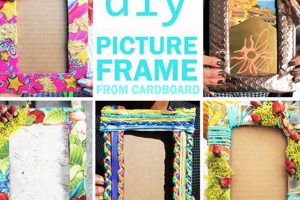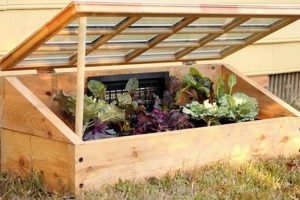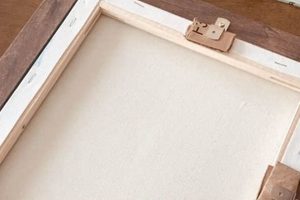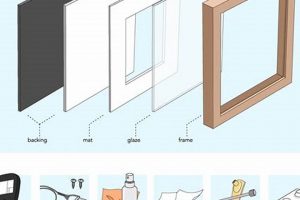The concept involves crafting enclosures for photographs, artwork, or other visual displays using materials and techniques accessible to individuals undertaking projects independently. This encompasses a wide range of methods, from repurposing existing items to constructing frames from raw materials such as wood, metal, or recycled materials. For example, a person might create a decorative border for a photograph using reclaimed wood scraps and basic carpentry tools.
Engaging in such activities offers several advantages, including cost savings, opportunities for personalization, and the promotion of creativity and resourcefulness. Historically, frame making was a specialized craft. The modern accessibility of materials and information has democratized the process, allowing individuals to create customized presentations for their cherished images and artwork. This approach also encourages sustainable practices by utilizing repurposed and recycled materials, reducing waste and promoting environmental responsibility.
The following sections will explore various techniques, materials, and design considerations applicable to the construction of personalized display solutions. These considerations include selection of materials based on desired aesthetic and durability, joinery methods to ensure structural integrity, and surface finishing techniques to enhance the visual appeal of the completed project.
Essential Considerations for Creating Personalized Displays
The following guidance offers critical points to consider when undertaking the construction of enclosures for visual media. Careful attention to these aspects will ensure both the aesthetic appeal and structural integrity of the finished product.
Tip 1: Material Selection: Prioritize materials that complement the artwork or photograph being framed. Wood offers warmth and versatility, while metal provides a sleek, contemporary aesthetic. Consider archival-quality backing materials to prevent degradation of the enclosed item over time.
Tip 2: Precise Measurement and Cutting: Accurate dimensions are essential for a professional-looking result. Utilize a miter saw or miter box for precise angled cuts, ensuring tight corners and a visually seamless construction.
Tip 3: Secure Joinery Techniques: Employ robust joinery methods such as wood glue and nails, screws, or dowels to create durable corner connections. Reinforce joints with corner brackets for added stability, particularly for larger frames.
Tip 4: Surface Preparation and Finishing: Thoroughly sand all surfaces to achieve a smooth, even finish. Apply primer before painting or staining to enhance adhesion and color consistency. Multiple coats of sealant provide protection against moisture and UV damage.
Tip 5: Consideration of Glazing Options: Evaluate different glazing options to protect the enclosed artwork. Glass offers clarity, while acrylic is lighter and shatter-resistant. UV-filtering glazing minimizes fading and degradation of the artwork from exposure to light.
Tip 6: Hardware Selection: Choose appropriate hanging hardware based on the weight and size of the finished frame. D-rings and picture wire are suitable for lighter frames, while heavier frames may require sawtooth hangers or specialized mounting brackets.
Tip 7: Backing Board and Fasteners: Use acid-free foam core or mat board as a backing to prevent damage to the artwork. Secure the backing board with flexible points or brad nails, ensuring a tight seal to prevent dust and insects from entering the frame.
By adhering to these principles, the resulting enclosures will effectively showcase and safeguard valuable visual materials, offering a personalized and lasting presentation.
The subsequent discussion will delve into specific design styles and creative embellishment techniques, allowing for further customization of the finished product.
1. Material Selection
Material selection represents a foundational element in creating enclosures for visual displays, influencing both the aesthetic and functional properties of the finished product. The choice of materials has a direct causal effect on the frame’s overall appearance, durability, and ability to protect the enclosed artwork. For instance, using untreated softwood might result in a frame that is inexpensive but prone to warping and damage from humidity, while employing hardwood like oak or maple creates a more robust and visually appealing, albeit costlier, structure. Recycled materials, such as pallet wood or repurposed metal, can offer unique textures and a sustainable approach but may require additional preparation and finishing to ensure structural integrity and prevent potential hazards.
The significance of material selection extends to the long-term preservation of the artwork. Acidic materials can leach into the artwork, causing discoloration and deterioration. Archival-quality materials, such as acid-free mat board used as a backing, prevent such damage. Furthermore, the chosen material’s texture and color should complement, rather than detract from, the artwork. A highly ornate, metallic frame may overwhelm a delicate watercolor painting, while a simple, natural wood frame might enhance its subtle beauty. Practical application of this understanding involves carefully considering the artwork’s medium, color palette, and style before making a material decision. For example, photographs often benefit from simple, contemporary frames made from metal or black-stained wood, while oil paintings can accommodate more elaborate and textured frames.
In summary, material selection is not merely a stylistic choice but a critical determinant of the final product’s quality and longevity. Challenges in this area include balancing cost constraints with the desire for high-quality, archival-safe materials. Understanding the properties of different materials and their interaction with the enclosed artwork is essential for creating a frame that effectively showcases and preserves valuable visual assets. This careful consideration of materials underscores the holistic approach necessary for successful project execution within the broader theme of personalized image displays.
2. Precise Measurements
Accurate dimensions are fundamental to the successful creation of personalized image displays. Deviations from specified measurements can compromise both the aesthetic appeal and structural integrity of the finished enclosure. Precise adherence to defined dimensions is therefore not merely a technical detail but a core prerequisite for achieving a professional and lasting outcome.
- Corner Alignment and Structural Stability
Inaccurate measurements result in misaligned corners, undermining the structural soundness of the entire frame. A frame with uneven corners will be weak, prone to warping, and unable to securely hold the artwork. For example, if one side is even slightly shorter than the opposite side, the corner joints will experience undue stress, potentially leading to failure over time. This compromises the frame’s ability to protect the enclosed visual media and detracts from its visual appeal.
- Glazing and Backing Board Fit
Precise measurements are essential for ensuring a proper fit for the glazing and backing board within the enclosure. Undersized glazing or backing will leave gaps, allowing dust and insects to enter, potentially damaging the artwork. Conversely, oversized components will not fit within the frame, requiring further adjustments or rendering the entire construction unusable. The tolerance for error in these measurements is minimal, often requiring accuracy to within a millimeter.
- Uniform Border Width
Achieving a visually pleasing presentation necessitates consistent border widths around the artwork. Inconsistent measurements lead to uneven borders, creating a perception of amateur craftsmanship and detracting from the artwork’s presentation. Accurate cuts and precise assembly are crucial for maintaining uniform border widths, ensuring that the frame enhances, rather than distracts from, the enclosed visual media. Professional displays rely on the eye to follow the golden ratio, and misaligned borders are a distraction from that view.
- Overall Frame Dimensions and Display Compatibility
Precise measurements determine the overall dimensions of the completed frame, influencing its compatibility with intended display locations. A frame that is too large may not fit within a designated wall space, while one that is too small may appear disproportionate. Accurate planning and measurement ensure that the finished product seamlessly integrates into its intended environment, fulfilling both aesthetic and functional requirements.
The connection between precise measurements and the quality of personalized image displays is undeniable. Adherence to accurate dimensions is not merely a technicality; it is a fundamental requirement for creating enclosures that are both visually appealing and structurally sound. Neglecting this aspect compromises the frame’s ability to protect the enclosed artwork and detracts from its overall presentation, highlighting the critical role of precision in achieving professional-quality results.
3. Secure Joinery
Within the realm of image display construction, secure joinery stands as a critical determinant of structural integrity and longevity. The method by which the frame’s components are connected directly influences its ability to withstand stress, resist warping, and maintain its aesthetic form over time. Consequently, the implementation of robust joinery techniques is not merely a matter of craftsmanship but a fundamental engineering consideration in the context of such projects. For instance, a frame constructed using simple butt joints, relying solely on glue for adhesion, will likely fail under moderate stress, particularly if exposed to fluctuating humidity levels. Conversely, a frame employing mitered corners reinforced with splines or dowels exhibits significantly greater resistance to deformation and separation.
The selection of appropriate joinery methods is contingent upon several factors, including the type of material used, the size and weight of the frame, and the desired aesthetic. For wooden frames, options range from basic butt joints and miter joints to more complex techniques such as mortise and tenon joints or dovetail joints. Each method offers varying degrees of strength and visual appeal. Metal frames may utilize welding, brazing, or mechanical fasteners such as screws and rivets to create secure connections. The choice of joinery also impacts the finishing process. For example, exposed fasteners may require filling and sanding to achieve a seamless appearance, while concealed joinery methods preserve the material’s surface integrity. Consider the example of a large, heavy frame intended to house an oversized canvas; in such a scenario, reinforced miter joints with metal corner brackets would provide the necessary structural support, preventing the frame from bowing or separating under the weight of the canvas.
In summary, secure joinery forms an indispensable element of successful image display construction. The application of appropriate techniques not only ensures structural stability but also contributes to the overall aesthetic quality and longevity of the finished product. The challenges associated with achieving secure joinery include the need for precision in cutting and assembly, as well as a thorough understanding of the properties and limitations of different joinery methods. Addressing these challenges through careful planning, meticulous execution, and the selection of appropriate materials and techniques is essential for creating frames that effectively showcase and protect valuable visual assets. This focus on detail connects directly to the broader theme of personalized image displays, where both aesthetics and structural integrity are paramount.
4. Surface Finishing
Surface finishing profoundly influences the aesthetic appeal and protective qualities of custom-created enclosures for visual media. The application of paints, stains, sealants, or other treatments directly impacts the frame’s visual character, enhancing or detracting from the artwork it contains. Furthermore, surface treatments provide a barrier against environmental factors such as moisture, UV radiation, and physical abrasion, thereby prolonging the frame’s lifespan and protecting the enclosed artwork. A raw, unfinished wooden frame, for instance, is susceptible to warping, cracking, and insect infestation, whereas a properly sealed and finished frame offers significantly greater resistance to these damaging effects. The choice of finish also dictates the frame’s cleanability and maintainability; a smooth, glossy finish is easier to clean than a rough, porous one.
Different surface finishing techniques impart distinct visual characteristics. Staining allows the natural grain of the wood to remain visible while adding color and depth, suitable for rustic or traditional aesthetics. Painting offers greater color versatility and opacity, ideal for contemporary or minimalist designs. Varnishing or lacquering provides a durable, protective layer with varying degrees of sheen, from matte to high-gloss. Waxing imparts a soft, natural luster and offers limited protection against moisture. Consider, for example, a photograph intended for display in a humid environment; applying a marine-grade varnish to the frame would offer superior protection against moisture damage compared to a simple coat of paint. Similarly, artwork sensitive to UV radiation benefits from a frame finished with a UV-resistant sealant, mitigating the risk of fading and degradation.
In essence, surface finishing is a critical component in the construction of personalized displays. Proper application not only enhances the frame’s visual appeal but also provides essential protection for both the frame itself and the artwork it contains. Challenges associated with surface finishing include selecting the appropriate materials and techniques for the specific material and intended environment, as well as achieving a consistent and durable finish. Mastering these techniques enables the creation of enclosures that effectively showcase and safeguard valuable visual assets, underscoring the interconnectedness of aesthetics and functionality in the broader context of custom display construction.
5. Glazing Options
Glazing constitutes a critical component of personalized display construction, directly affecting both the aesthetic presentation and preservation of enclosed visual media. The selection of appropriate glazing options is not merely a stylistic consideration but a functional requirement dictated by the artwork’s characteristics and the intended display environment. The absence of glazing, for example, exposes artwork to dust, pollutants, and physical damage, while the use of inappropriate glazing can accelerate degradation through UV exposure or moisture condensation. Therefore, understanding the properties of different glazing materials and their interaction with the enclosed artwork is paramount.
Various glazing options cater to specific needs and constraints. Glass offers clarity and scratch resistance but is relatively heavy and prone to shattering. Standard glass provides minimal UV protection, potentially causing fading and discoloration of sensitive artwork. Acrylic, a lightweight and shatter-resistant alternative, is available in UV-filtering grades that mitigate the damaging effects of ultraviolet light. However, acrylic is more susceptible to scratching than glass. Specialized glazing materials, such as museum-grade glass and acrylic, offer enhanced UV protection and anti-reflective properties, maximizing visibility and minimizing glare. Consider the practical example of a watercolor painting; unprotected exposure to sunlight will cause significant fading over time. Employing UV-filtering acrylic glazing will substantially extend the artwork’s lifespan, preserving its original colors and details.
In summary, glazing options represent a crucial decision point in the construction of personalized image displays. The choice of glazing material directly impacts the artwork’s visual presentation and long-term preservation. Challenges in this area include balancing cost considerations with the need for adequate protection and aesthetic appeal. A thorough understanding of the properties and limitations of different glazing materials is essential for creating displays that effectively showcase and safeguard valuable visual assets, thereby underscoring the importance of informed decision-making within the broader context of customized display construction.
6. Hardware Integration
The incorporation of appropriate hardware is an indispensable aspect of personalized visual display construction. The selection and application of hardware components directly influence the frame’s functionality, stability, and aesthetic cohesion. A poorly chosen or improperly installed hardware element can compromise the frame’s ability to securely support and present the enclosed artwork, diminishing its overall quality.
- Hanging Mechanisms and Weight Considerations
The selection of hanging mechanisms, such as D-rings, sawtooth hangers, or wire systems, must align with the frame’s weight and dimensions. Underestimating the frame’s weight can lead to hanger failure, resulting in damage to both the frame and the artwork. Conversely, using excessively robust hardware for a lightweight frame can appear visually disproportionate. Correct hardware selection ensures secure and aesthetically pleasing wall mounting. For example, a large, heavy frame necessitates the use of heavy-duty D-rings and picture wire capable of supporting its weight, while a small, lightweight frame may only require a simple sawtooth hanger.
- Fasteners and Joint Reinforcement
Fasteners, including nails, screws, and brad nails, play a crucial role in securing the frame’s joints. The type and size of fastener must be appropriate for the materials being joined. Insufficiently sized fasteners can result in weak joints, prone to separation over time. In certain instances, supplemental joint reinforcement, such as corner brackets or metal plates, may be necessary to enhance structural integrity, particularly for larger or heavier frames. For example, mitered corners can be reinforced with metal brackets to prevent them from separating under stress.
- Backing Board Retainers
The method of securing the backing board, typically using flexible points, brad nails, or turn buttons, is essential for preventing dust and insects from entering the frame and damaging the artwork. Flexible points offer a non-permanent solution, allowing for easy removal and replacement of the artwork. Brad nails provide a more secure, but less easily reversible, option. Turn buttons offer a visually appealing and relatively secure method of retaining the backing board. For example, acid-free foam core can be secured with flexible points and easily replaced if damaged. Turn buttons or brad nails provide more security and visual appeal.
- Decorative Hardware and Aesthetic Integration
Decorative hardware, such as ornate corner embellishments or decorative tacks, can enhance the frame’s aesthetic appeal and complement the artwork. However, the selection of decorative hardware must be carefully considered to ensure that it aligns with the overall design and does not detract from the artwork’s presentation. Overly ornate or mismatched hardware can overwhelm the artwork and create a visually jarring effect. For example, simple and sleek hardware can be used with modern frames; conversely, vintage or rustic hardware can be combined with vintage or rustic frames.
The appropriate integration of hardware components is a key determinant of a successful personalized image display project. Correct selection and application of hardware not only ensures structural stability and functional performance but also contributes to the overall aesthetic quality of the finished product. Neglecting this aspect can compromise the frame’s ability to effectively showcase and protect the enclosed artwork. The integration also elevates the design that might be simple and cheap. Each is designed to complement the main idea of a frame: to highlight the picture, photograph, or art it contains.
Frequently Asked Questions Regarding Personalized Visual Media Enclosures
This section addresses common inquiries and misconceptions concerning the design, construction, and maintenance of customized enclosures for images, photographs, and artwork. The information provided is intended to offer practical guidance and informed decision-making for individuals undertaking such projects.
Question 1: What materials offer the optimal balance of cost-effectiveness and archival safety for framing valuable photographs?
Archival-quality mat board and acid-free foam core represent suitable backing materials for preserving photographic integrity. Frame materials such as poplar wood offer a cost-effective, stable base for construction. Standard glass, while providing adequate protection from physical damage, lacks UV filtration. Consider UV-filtering acrylic for enhanced protection against light-induced degradation.
Question 2: What joinery techniques are recommended for constructing frames intended to support substantial weight, such as large canvas paintings?
Mitered corners reinforced with splines or dowels offer increased structural rigidity compared to simple butt joints. Metal corner brackets provide supplemental support, preventing separation under load. The selection of high-strength adhesives specifically formulated for wood or metal is essential for ensuring joint integrity.
Question 3: What steps can be taken to minimize dust and insect intrusion within the framed enclosure?
Employing a tight seal between the glazing, artwork, and backing board is critical. Securing the backing board with flexible points or brad nails creates a barrier against contaminants. Applying archival-quality sealing tape along the frame’s interior edges further reduces the risk of intrusion.
Question 4: How can one achieve a professional-quality finish when applying paint or stain to custom-built frames?
Thorough surface preparation, including sanding and priming, is essential for achieving a uniform finish. Multiple thin coats of paint or stain, applied with high-quality brushes or spray equipment, produce superior results compared to a single thick coat. Allowing adequate drying time between coats is crucial for preventing imperfections.
Question 5: What are the advantages and disadvantages of using acrylic versus glass for glazing artwork intended for display in high-traffic areas?
Acrylic is lightweight and shatter-resistant, making it a safer option for high-traffic areas. However, acrylic is more susceptible to scratching than glass. Museum-grade acrylic offers enhanced scratch resistance and UV protection but at a higher cost. Glass offers superior clarity and scratch resistance but is heavier and more prone to breakage.
Question 6: What hanging hardware is appropriate for frames of varying weights and sizes, and how should it be installed to ensure secure display?
Lightweight frames can be adequately supported with sawtooth hangers. Heavier frames require D-rings and picture wire. When installing D-rings, ensure they are securely fastened to the frame using screws of appropriate length and gauge. Utilize wall anchors suitable for the wall material and the frame’s weight. Employ a level to ensure the frame is hung straight.
The preceding answers provide a framework for addressing common concerns related to customized visual media enclosures. Thoughtful consideration of these points will enhance the aesthetic appeal and longevity of such projects.
The subsequent section will provide a conclusion summarizing the key principles of personalized display construction.
DIY Picture Frame Ideas
The preceding discourse has elucidated the multifaceted nature of crafting customized enclosures for visual media. From meticulous material selection to the application of secure joinery techniques, each element contributes to the final product’s aesthetic merit and structural integrity. Surface finishing and appropriate glazing options further augment the frame’s protective capacity and visual appeal, safeguarding valuable artwork against environmental degradation. The correct integration of hardware ensures secure and stable display.
Effective execution demands a comprehensive understanding of materials, techniques, and design considerations. The challenges inherent in this endeavor necessitate a commitment to precision and a recognition of the lasting impact of thoughtful craftsmanship. The enduring value of personalized display construction lies not only in the aesthetic enhancement of visual media but also in the preservation of cultural and personal legacies for future generations. Therefore, adherence to the outlined principles is paramount for those seeking to create enduring showcases for their treasured images and artwork.







